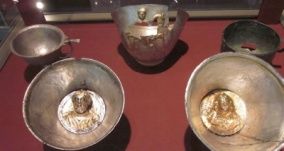

The treasure was discovered in 1929 in the village Bukyovtsi, the municipality Oryahovo. It consists of a silver barring, two silver phials, silver with gold jewelries, a golden silver bowl, a diadem in the shape of a hawk, application of two lotus flowers connected between them. The archeologists date it to the end of the 5th century b. Chr.
The discovery from the city Mizia is the second biggest Thracian treasure, discovered in the north – west of Bulgaria. It contains an ornament, a few silver applications for horses. Their shape and the execution pattern allow the treasure to be dated between the end of the Vth century and the beginning of the IVth century b. Chr.
Interesting is the story of its discovery, described in detail. The treasure developer Alexander Vitanov in the month of February 1925 discovered by accident a part of it in the domain from the resting area, situated at 2 km south from Bukyovtsy (Misia). This was buried in a whole, at a small depth from the surface of the ground – 40 cm a water boiler, a small vase and a female gender ornament, which were immediately sent to the National Museum of Archeology from Sofia. Unknown is the destiny of other silver objects which remain at the discoverer. In the spring of the year 1935 Alexander Vitanov decided to make a cabin in the same locality. That was when he dug the ground and found a second part of the treasury, buried at the same depth in the proximity of the place in which ten years ago, he discovered the first part. The second part is composed by silver with gold cup, more cruses and a large number of bottles and applications for the horse harness, also, executed in silver. Alexander Vitanov immediately went to Sofia, where he met the Armenian goldsmith Saanian and established the selling conditions. The silversmith also resells a part to the National Museum of Archeology – a cup, two vessels, a part of the ornaments for the horse harness. The faith of the remained elements for the second part isn’t known and they are irremediably lost for the science from Bulgaria.
The treasure Bukystsy presents excellent examples for the production of jewels. Among them a principal place is occupied by the silver ornaments. These are composed by five fibulas in the shape of a safety pin, which are the decorative ornaments. These, by the means of some hooks, are attached to the decorative heads. Under each one of them it is found the bow, one of them has a great and generous decoration. They have been connected between them through a knitted cordon of silver staples. Of it there were hung the spherical and oval pendants. Maybe this ornament decorated the chest of the Thracian commander being transmitted from generation to generation.
The silver cup is magisterial. Its surface is superficially stitched by cut, accentuating its shape. Right under the whole is incised the golden belt with floral and geometrical ornaments. This cup is different from other objects made of silver, with its shape and its fine decorations. It had a special place in the service of the Thracian prince.
Obvious is the fact that the Bukyovtsy treasure us hidden in two parts because of the danger. They are buried in wholes of a small depth, situated in the immediate proximity one to another. It seems that the circumstances in which the objects have been buried are the same as the ones with the burying of the treasury from Rogozen, collected from various generations of Thracians commanders between the centuries VI and IV BC. This treasure is adapted to the chronological radius of the treasure from Bukyovtsy. There is a resemblance in the execution pattern and in the shape of the vessels from the two treasures. Moreover – the striking resemblance suggests unity. But in the execution of the cruses from the treasury from Rogozen there is a separate type from the Bukyovtsy type. Consequently, the hypothesis that the discoveries from the two cities are actually parts from the same treasure has its reasons.
The Bukyovtsy treasure is a proof of the vicissitudes of the human life. It belonged to a family of leaders, from a sumptuous decoration and demonstrates the power and the wealthiness of the guests.
